Source: Kaiko Research; Compiled by: Baishui, Golden Finance
Despite encouraging U.S. inflation data last week, the cryptocurrency market is still volatile. According to recent quarterly reports, Goldman Sachs and Morgan Stanley held large positions in various Bitcoin ETFs at the end of the second quarter. In addition, Binance reached a settlement with India's Financial Intelligence Department and hopes to return to the Indian market. This week, we will explore:
The prospects of crypto projects investing in treasury bonds;
ETH gas fees reach a multi-year low;
Investor interest in AI token projects remains sluggish.
This week's trend
Interest rate cuts are unlikely to limit the appeal of tokenized treasury bonds.
BlackRock’s on-chain tokenized fund BUIDL (BlackRock USD Institutional Digital Liquidity Fund) is one of many funds launched in the past 18 months that provide exposure to traditional debt instruments such as US Treasuries. It has quickly become the largest on-chain fund by assets under management (AUM). The fund was launched in March 2024 in partnership with Securitize and has attracted inflows of more than $520 million to date.
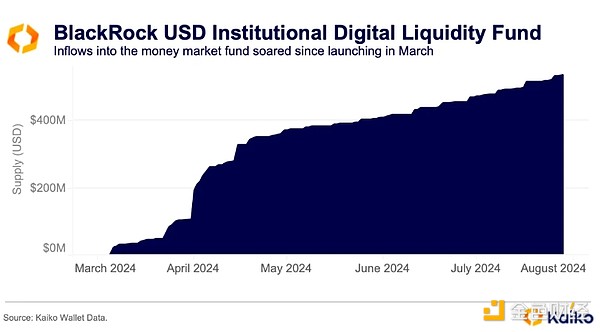
Most of these funds invest in short-term US debt instruments. Other top funds include Franklin Templeton’s FBOXX, Ondo Finance’s OUSG and USDY, and Hashnote’s USYC. Each fund’s yield is aligned with the federal funds rate.
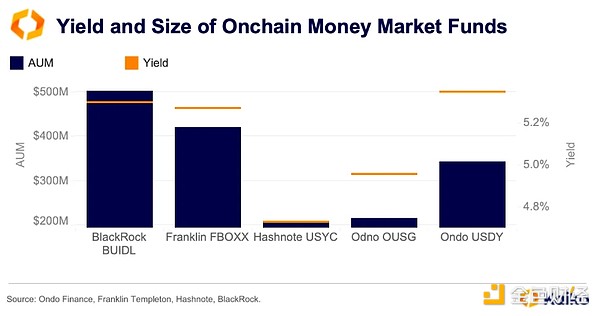
As hype around these tokenized funds continues to heat up, both on-chain flows and secondary markets for related tokens have seen an increase in activity.Ondo Finance’s governance token ONDO experienced the largest surge in trading, coinciding with the announcement of its partnership with BlackRock’s BUIDL. ONDO’s price hit an all-time high of $1.56 in June on the back of surging BUIDL inflows and growing interest in on-chain funds. However, the hype has since faded, and inflows may face resistance as the U.S. interest rate environment changes.
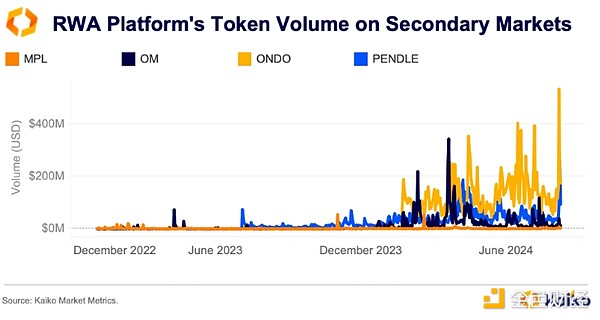
Since the August 5 sell-off, the narrative that the Fed is behind the curve and needs to cut rates more aggressively to avoid a recession has intensified, with the market currently pricing in a 100 basis point rate cut this year.
Last week's weaker-than-expected U.S. inflation data reinforced expectations for a rate cut in September. However, a rate cut does not necessarily mean loosening monetary policy. If the Fed cuts nominal rates, but inflation falls at the same or faster pace, real rates (nominal rates adjusted for inflation) may remain stable or even rise.
Indeed, the real federal funds rate, adjusted for the producer price index (PPI) (a measure of business pricing power), has risen modestly this year even as the Fed has kept nominal rates stable.
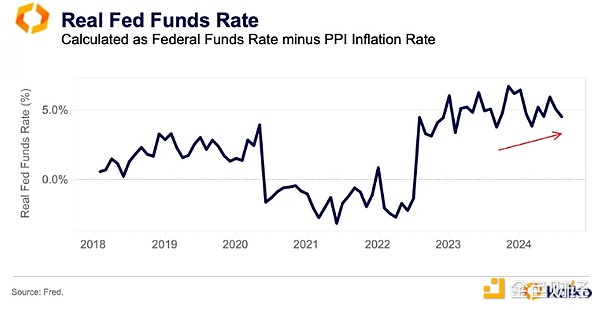
If real interest rates remain stable, the potential stimulus effect of the Fed's rate cut may be weaker than expected. In this case, U.S. Treasuries may still be attractive compared to risky assets as investors may prefer liquidity and security rather than risk.
Data worth paying attention to
The impact of a sharp drop in Ethereum gas fees on supply.
Ethereum’s gas fees recently hit a five-year low, helped by increased Layer 2 activity and the March Dencun upgrade, which reduced Layer 2 transaction fees. This fee reduction has an impact on ETH because lower fees mean less ETH is burned, increasing the token’s supply. As a result, ETH’s total supply has been rising consistently since April. Despite demand drivers such as the spot ETH ETF, this growing supply could keep a lid on potential price gains in the near term.
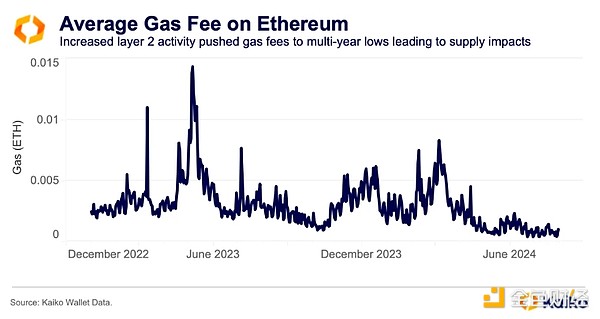
AAVE collateral demand cools.
Aave V3, the largest DeFi lending protocol by TVL, saw demand for collateralized loans cool in August after more than $260 million was liquidated amid the cryptocurrency price crash and market-wide sell-off that began on August 5.
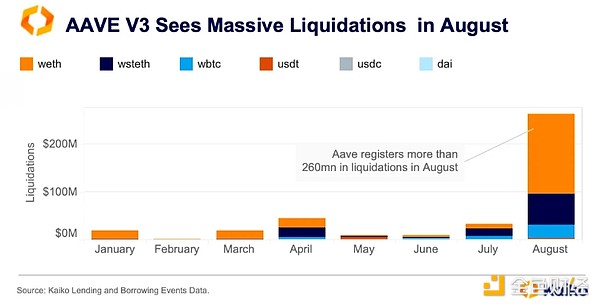
Aave V3 recorded net inflows between May and July, with borrowings exceeding repayments. In July, stablecoin borrowings hit a year-to-date high of $1.4 billion, while repayments totaled $1.2 billion, with net inflows reaching about $200 million. However, following the recent sell-off, the trend has reversed, with net outflows exceeding $200 million since the beginning of the month.
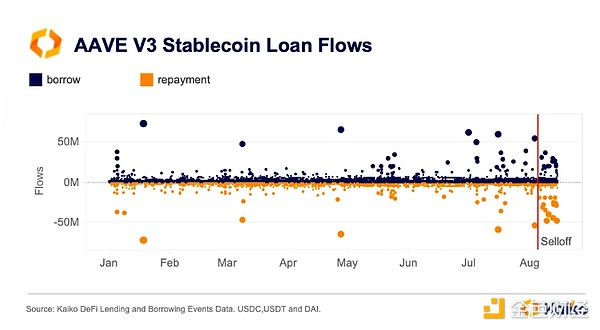
AI Crypto Token Merger Efforts to Rekindle Market Interest.
Last month, three major AI-focused crypto projects — Fetch.AI, SingularityNET, and Ocean Protocol — launched the first phase of merging their native tokens into a single token, dubbed the Artificial Intelligence (ASI) Token. The merger, originally announced in March, is part of a broader plan to develop a new AI platform that will provide a “decentralized alternative to existing AI projects controlled by large tech companies.”
Since July, the combined market share of SingularityNET’s AGIX, Ocean Protocol’s OCEAN, and Fetch.AI’s FET tokens has risen from 30% to 40%. However, our tick-by-tick data shows that this increase was primarily driven by increased selling, suggesting that traders view consolidation as a risk event.
Since the start of Q2, overall demand for AI tokens has fallen sharply. Weekly volumes plummeted to $2 billion in early August, a sixfold drop from Q1’s multi-year high of over $13 billion.
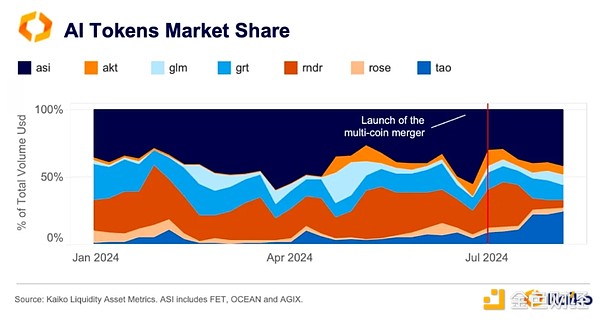
AI-related crypto tokens are correlated to projects that use AI to improve security, user experience, support decentralized exchanges, or provide image and text generation services. However, their 60-day correlation with chipmaker Nvidia (NVDA), which is widely considered a bet on a potential AI-related boom, has been weak. Currently, the correlation hovers around 0.1-0.2, down from a peak of 0.3-0.4 in March. In contrast, their correlation with Bitcoin remains strong, ranging from 0.5 to 0.7 as of early August, suggesting that traders view these projects as high-beta crypto bets.
FDUSD Market Share Hits All-Time High on Binance.
At the end of July, the stablecoin FDUSD’s market share on Binance hit an all-time high of 39%, reversing a downward trend that had persisted over the past three months. This growth is notable because the exchange reintroduced zero commissions on FDUSD trading pairs for regular and VIP-1 users back in April.
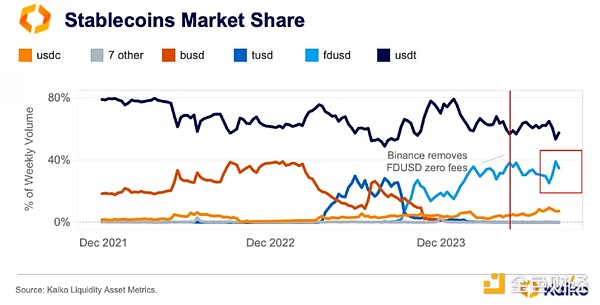
A closer inspection of the tick-by-tick data shows that the surge in FDUSD volume was primarily driven by increased buying of Binance’s four main FDUSD-denominated pairs, as well as rotations into other stablecoins, notably Tether’s USDT.
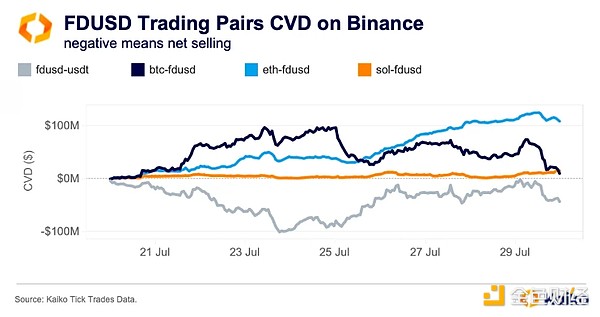
This is particularly interesting because Bitcoin saw a strong sell-off in Binance’s USDT markets during the same period (not charted).
Hong Kong-regulated First Digital USD (FDUSD) was launched in June 2023 and soon after began trading on Binance with no maker and taker fees. By 2024, its daily trading volume had soared to an average of $6.5 billion, more than six times the volume of the second-largest stablecoin, USDC ($1 billion). However, FDUSD’s success was largely dependent on Binance, as it was traded exclusively on the platform and was closely tied to its fee policy.
Japanese markets lead the crypto sell-off.
The Bank of Japan’s rate hike in late July was a precursor to a spike in financial market volatility in August. Crypto markets plunged along with equities as a shift in Japan’s interest rate environment and poor U.S. economic data spooked investors.
The fallout from the first weekend of August hit crypto markets immediately. BTC fell more than 12% over the weekend, dropping below $50,000 by Monday morning European time. During the sell-off, volumes on Japanese cryptocurrency exchanges surged, particularly on Bitbank and Bitflyer, reaching their highest points since Bitcoin’s record high in early March.
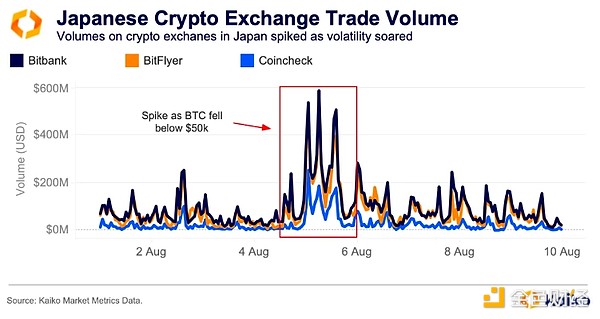
The surge in trading volume was mainly due to trading activity in the BTC-JPY market, followed by the ETH-JPY and XRP-JPY markets. However, the Japanese cryptocurrency market saw an interesting surge in ETH's trading volume share on Saturday night Japan time, accounting for more than 30% of the trading volume at one point. The surge in trading volume occurred a day before most of the volatility and coincided with a panic caused by reports that Jump Trading had begun to liquidate its ETH positions.
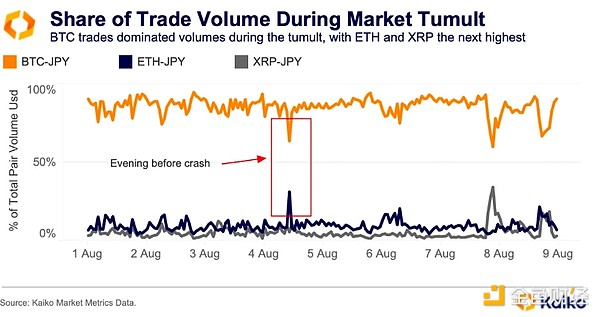
What is behind the preemptive moves by the Japanese market relative to the U.S. and other major regions? A large part of the volatility in early August is related to the yen carry trade.
The carry trade involves traders borrowing an asset (in this case, the yen) at a low interest rate and reinvesting it in a higher-yielding asset, such as U.S. Treasuries. Considering that Japanese investors are the largest non-U.S. investor group in U.S. Treasuries, most are likely invested in both assets at the same time. This investment coincides with the surge in the likelihood of a rate hike by the Bank of Japan and a rate cut by the Federal Reserve.
Carry trades work best when markets are stable. So when the Bank of Japan raised interest rates for the second time since 2007, the trade suddenly lost its appeal.
 JinseFinance
JinseFinance


















